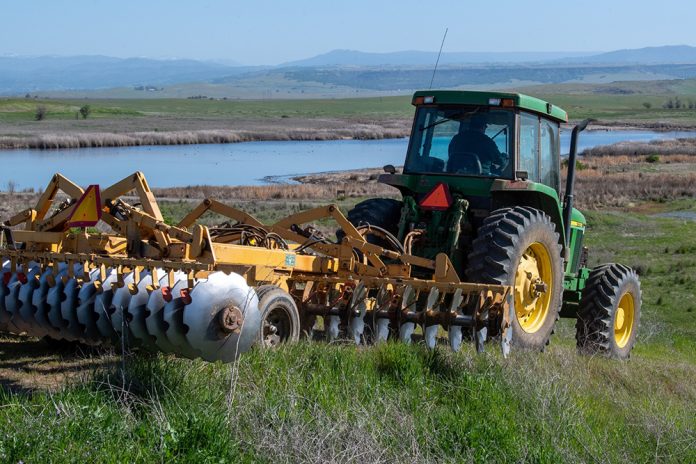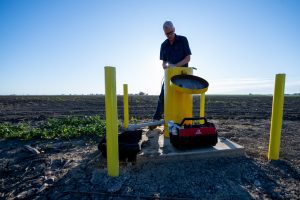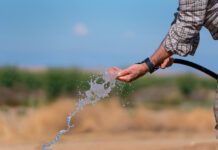
LandFlex, a program intended to help solve California’s groundwater crisis, recently awarded $23.3 million in block grants to groundwater sustainability agencies (GSAs) in California to distribute to farmers who took action to limit their agricultural water use.
“The objective of LandFlex is to replenish critically overdrafted groundwater basins in areas of need and retire the use of overdraft on enrolled agricultural acres,” said Kris Tjernell, deputy director of Integrated Watershed Management for the California Department of Water Resources (DWR). “That may mean for some growers enrolled in LandFlex future farming may not look the same, but LandFlex is providing a financial incentive to transition ag lands to sustainable use. Some may feel that is a benefit. Overall, this program may not make financial sense for all growers, but it will make sense for some.”
“LandFlex is a voluntary and solutions-based program assisting vulnerable communities in solving the groundwater crisis related to drought by protecting domestic wells through preventative fallowing, relieving supply pressures and providing water supply and economic certainty to critically overdrafted basins,” explained Aubrey Bettencourt, president/CEO of the Almond Alliance, in the February 2023 issue of West Coast Nut.
The program is the result of a partnership of the DWR, the Western United Dairies Foundation, the Almond Alliance, Self-Help Enterprises and the Community Alliance with Family Farmers.

As part of the program, GSAs work with farmers to identify land that would reduce the use of nearby wells. LandFlex provides financial incentives for each enrolled acre, allowing farmers flexibility to manage their land through serious conditions, such as a drought or a flood, and leave water in the ground to stabilize their aquifers and to help replenish drinking water wells in California’s most vulnerable communities.
“Our farmers can stay in operation and have operating capital on a voluntary and annual basis while supporting our communities and ensuring sustainable working farmland and a secure food supply for the future,” stated a DWR release.
LandFlex is intended to benefit small and mid-sized farms. Program eligibility is limited to growers with a three-year average adjusted gross income of no more than $2.5 million. Program partners, such as Community Alliance with Family Farmers, Self-Help Enterprises, Western United Dairies Foundation and the Almond Alliance, assist GSAs by providing outreach to growers.
Unused Grant Money
Seven GSAs in the state were determined to be in critically overdrafted basins, qualifying them for the LandFlex block grants. Grants were awarded to three of them: Madera County Groundwater Sustainability Agency ($9.3 million), Greater Kaweah Groundwater Sustainability Agency ($7 million) and Eastern Tule Groundwater Sustainability Agency ($7 million).
However, two of those districts did not use all the money they received.
“We have accepted applications from growers in the three awarded basins, they will be starting implementation soon,” said Tjernell in early June. “However, the program did not expend all the funds as expected, so DWR will be opening the program for a Phase 2, which will only be open to the remaining four GSAs who applied for LandFlex and were eligible.”
In Phase 2, more than $10 million of unused funds is to be awarded to one or more of the following GSAs: Mid-Kaweah Groundwater Sustainability Agency, Lower Tule River Irrigation District, Pixley Irrigation District and Westland Water District. Applications were to be received over a two-week period beginning on June 14.
Since there is a chance that not all the Phase 2 funds will be used, interested tree nut growers are encouraged to visit www.landflex.org for updates about any unused funds.
Funds from the LandFlex program have been distributed “50-50” between farmers with permanent crops (fruit and nut growers) and those with row crops, said Bettencourt.
The LandFlex program is for water year 2022-23, which started October 1, 2022 and runs through September 30, 2023. There has been no decision about continuing the program beyond that.
“We were only given funding by the (California) legislature for this round,” said Teji Sandhu, executive policy advisor to the deputy director of the California Department of Water Resources, who hopes the program will continue.
Many walnut growers pushed over their trees as the result of falling prices. Those growers who pushed over their trees during the 2022-23 water year were eligible to receive LandFlex funding to clear the trees off their land. Those who took that action before October 1, 2022, however, were not.
Simply idling a tree nut orchard does not qualify a grower for LandFlex funds, according to Tjernell.
“LandFlex doesn’t pay for idling tree crops; it pays when those trees are removed,” he said. “The grower would be the one who determines if that would be a benefit. This action may make sense if the grower looks ahead and considers SGMA (Sustainable Groundwater Management Act) implementation and market conditions, then decides it’s time to begin transitioning some of their land use practices.”
Both Sandhu and Bettencourt are among those pleased with the program so far.
“We have yet to see the benefits, but I’m hopeful the expected benefits are what we’re going to see on the ground,” said Sandhu.
“Farmers are learning there are programs out there [such as LandFlex], and we’re seeing a lot of positive response about that,” said Bettencourt.
One such program is offered by the California Department of Conservation (DOC) to fund groundwater sustainability projects that, among other goals, repurpose irrigated agricultural land. According to the DOC website, the Multibenefit Land Repurposing Program (MLRP) “seeks to use this funding to increase regional capacity to repurpose agricultural land to reduce reliance on groundwater while providing community health, economic wellbeing, water supply, habitat and climate benefits.” So far, the program has received $90 million in appropriations.
Sandhu noted, however, that MLRP applicants need to “come up with a 10-year plan, while LandFlex is a one-year program.”










